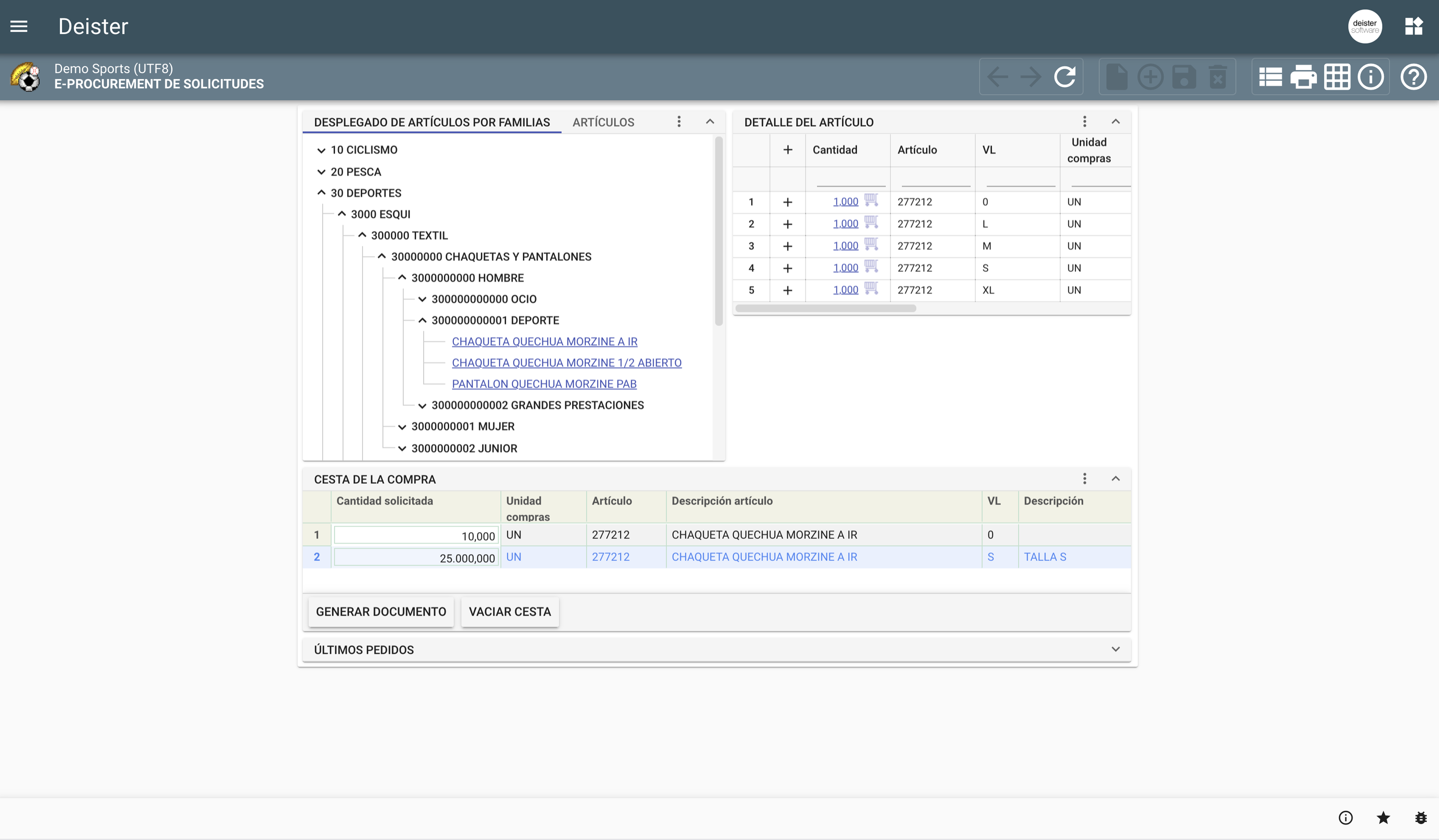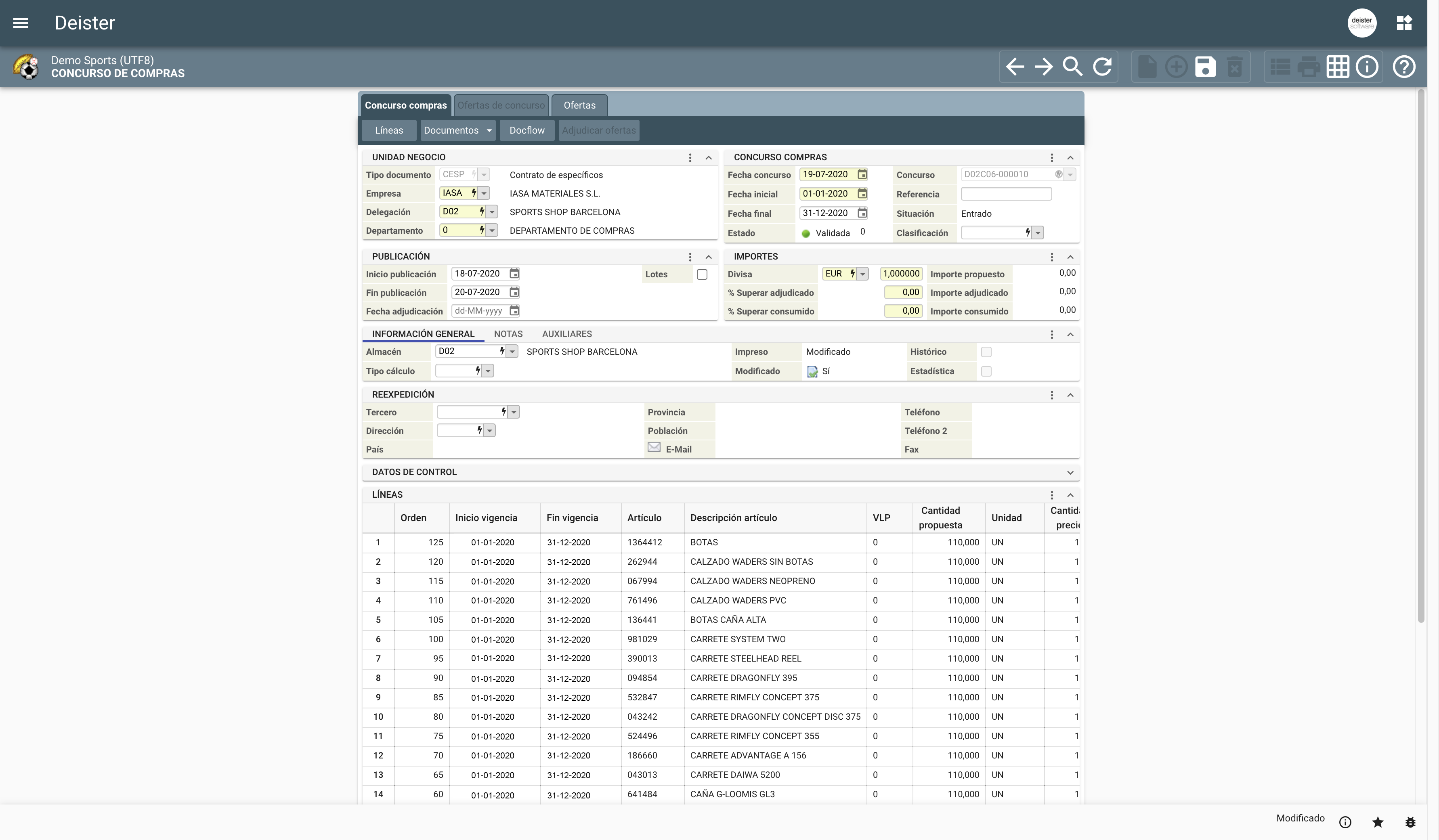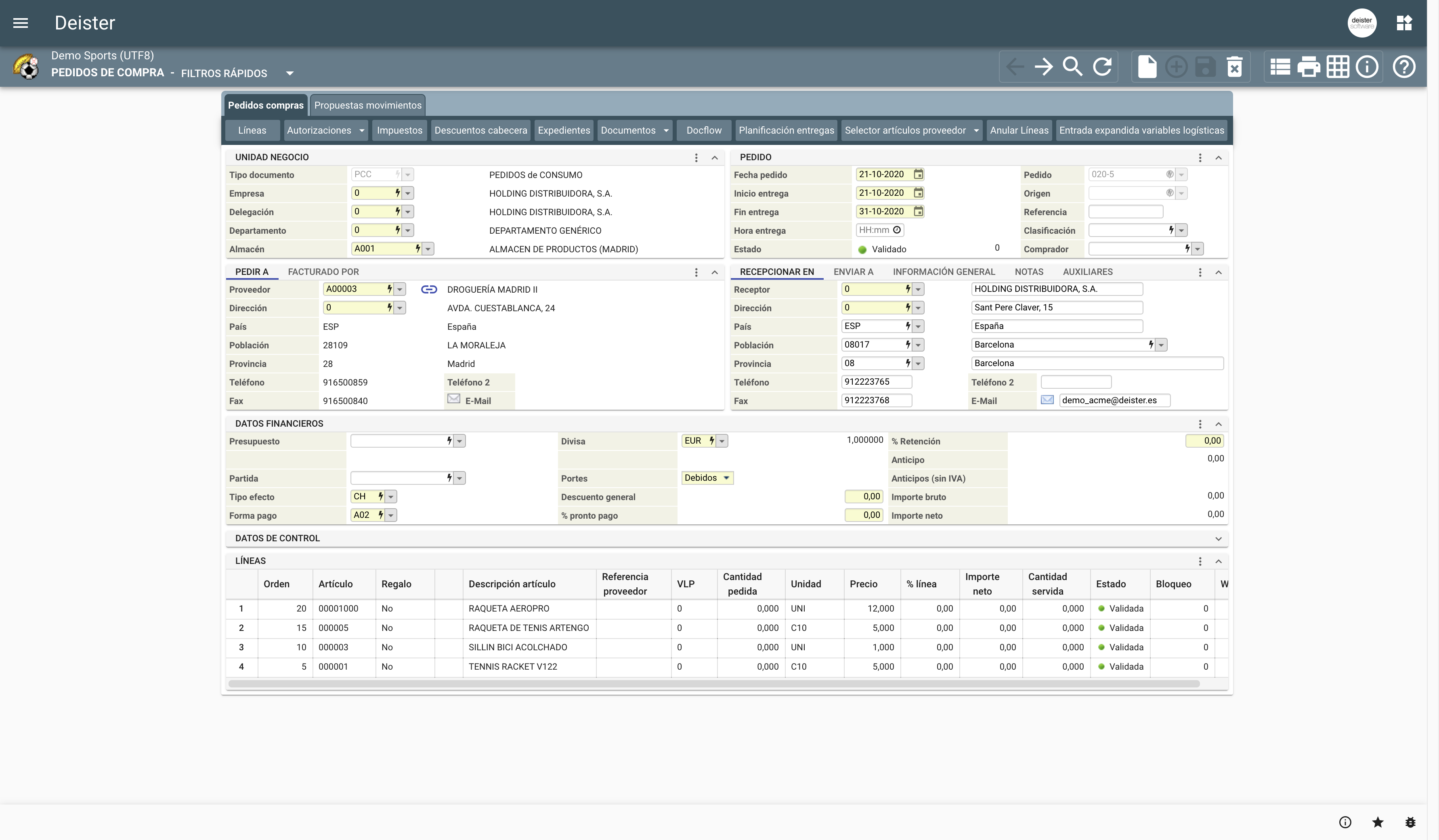Supplier Relationship Management (SRM)
Supplier Relationship Management (SRM)
Axional ERP/SRM goes beyond the simple automation of supply and purchase processes; rather, it actively enhances them. It incorporates all aspects of the supplier relationship with the utmost flexibility, easing decision-making with access to the necessary information at any moment.
By means of functionalities such as workflows and configurable documents with minimal requirements for information entry, and capabilities for multinational and multi-currency management, this solution simplifies the management of processes and workflows, reducing the impact of steps that diminish efficiency.
It provides a platform that covers all phases of a purchases process simply: incorporation of commercial terms and conditions from suppliers, offer and bid management, creation of purchase orders, receipt and invoicing of merchandise or services, and financial accounting of transactions (General Ledger, Cost Accounting, Taxes, Accounts Payable or Receivable, Refunds, etc.).
Likewise, Axional ERP/SRM is integrated with other modules, such as Warehouse Management (WMS), Import and Export Management (IEM), Sales, and Maintenance (CMMS). For instance, when a supply receipt enters records, the inventory updating process is activated; or, in a group of companies, a sale from one company in the group to another generates a purchase accounting document, as does a maintenance work order. Similarly, the module is integrated with financial accounting and accounts payable to log purchase transactions in the ledger, record accrued taxes, and facilitate administrative management of payments to suppliers.
Characteristics
The main characteristics are:
Axional ERP/SRM covers the complete range of suppliers and creditors to facilitate, among other aspects: commercial terms related to prices and discounts, purchase processes, management of relationships (referrals or contacts), and the storage of all information generated in communications with them.
Defining a supplier speeds up the entry of purchase documents, automatization of all relevant administrative information requirements (addresses, bank account data, payment conditions), as well as currency selection, commercial terms, representative, regular carrier, payment center, etc.
Axional ERP/SRM provides the flexibility you need to factor in all the functional characteristics of the terms and conditions agreed upon with suppliers and creditors. Includes the complete definition of price lists, discounts, bonuses, and purchase rebates.
Defining price lists allows you to specify dates of validity and days of the week on which to apply them, as well as priority order and desired currency. Prices, discounts and bonuses can be specified based on scaled ranges of purchase quantities. Likewise, the application of price lists allows:
- Setting prices according to presentation format or item classification (or independently of them).
- Applying unit conversion on items’ prices.
- Flexibility when establishing whether prices include VAT.
- Possibility of introducing net prices, omitting the application of discounts.
- Estimating cost items (cost evaluation, base cost for sale price, etc.) from the price lists themselves.
Price list creation can be activated once a supplier’s offer has been accepted, so that prices included in those offers are automatically integrated as new purchase prices with the same dates of validity as those of the offer, and have a higher priority than other active price lists from the same supplier.
Discounts
The definition of price lists is widely flexible at the level of document type, supply destination, supplier, producer, or article. With that same order of priority, discount amount lists are provided, both general as well as restricted to specific product lines, allowing specific parameters or conditions such as:
- Sequences of discounts applied on base price and/or cascading.
- Discounts by percentage, fixed amount, or gift.
- Channel and period of payment settlement.
- Breakdown of discount application by cost item.
- Settlement of discounts in differentiated cost notes.
- Flexible definition of document flows for purchase processes. The system allows you to access and restrict the relationship between any document and its source and destination documents.
- Automatization of repetitive purchase activities so that requesters can choose items from online catalogs or using preset models.
- Automatic loop of purchase approval processes.
- Ability to create purchase orders directly from supply requests, or from a request for bids by means of supplier offers.
- Worksheets for buyers that allow them to access archives of past purchase orders, view the profitability of every supplier, and reference contact information.
- Linking of multiple contracts, accounts, projects and destinations with one request or purchase order from a product line.
Axional ERP/SRM has a specific module to facilitate bid management for the purchase of items whose stocking may be preceded by bid and offer procedures.
This environment contains multiple functionalities which make these processes more agile and grant access to purchase bidding management information. In this sense, supplier offer management allows you to completely organize and track the cycle from offer to comparative valuation to awarding bids — including the subsequent setting of prices, catalogs and purchase decisions.

The module encompasses bidding-related functionalities such as:
- Item selection for those who will tender bids, not just by finding a specific item identification code but also by automatically selecting items based on multiple selection criteria that may complement each other, such as family, type, classification, manufacturer. These can also be applied as criteria for exclusion.
- Automatic generation of tender lines based on the items which meet the defined selection criteria.
- When generating tender lines, forecasted consumption for the period is calculated. The system factors in average consumption calculated via consumption statistics for the items selected. This average is obtained based on the calculation method you select, whose configuration may adapt according to the consumption characteristics of the items in question.
- Supplier selection for those who will create offers, based on specific selection criteria just as items are. Whether using supplier codes or other complementary parameters such as tax ID number, type, or classification, users can put restrictions on the selection of suppliers who will present offers, or even the exclusion of those that do not fit.
- Automatic offer generation for selected suppliers and items.
- For each supplier, an initial offer is generated with the items being bid on, as well as new offers for items which may be added later.
- Offers are initially generated with a price of 0, so offer lines with prices included may be awarded.
- Control of bid status: Entered, Tendered, Awarded, Abandoned, Finalized. This can be seen on a general level or an individual tender line level.
- Rewarding tender based on previously reported offers. The tender entity has a multiple-selection screen which allows them to mark lines for awarded offers and modify quantities awarded by the supplier.
- Prior to awarding a bid, the system ensures that at least one recorded offer exists.
- The awarding of bids can be carried out individually for an offer or sharing the initial proposed amount among various offers.
- The system also ensures that the total awarded amount does not exceed the amount proposed by line.
- Awarding a bid is reversible for as long as orders have not yet been made.
- Finalization of the bid awarding process:
- Generates orders automatically based on supplier offers whose lines have been awarded, by the amounts selected.
- Order generation includes the ability to create either an open order or monthly programming based on products’ seasonal nature.
- Purchase price creation based on data received from suppliers, whether they are awarding or simply offering.
- The system also incorporates commercial references and detailed descriptions of various suppliers making offers, prices, and bar codes.
- When the bidding process is finalized, offers not awarded will be nullified and the lines with no offers will transition to Abandoned status.
- Control over amounts and prices for awarded lines.
- Tracking of the amounts of prices awarded, ordered and consumed on a bid line level.
- Control over amount requested vs. amount awarded by bid line or aggregated by Lot, or bid line grouping.
- Reference to File in bids of entities of the public sector.
Offer Management
Offer management, in particular, includes functionalities which make supplier communication and the bid-awarding process more agile:
- Publication WEB Services for items the company wishes to acquire.
- Electronic notification to regular suppliers when a call for bids is published, based on supplier category.
- WEB interface allowing the supplier to connect directly to the system in order to enter:
- Item data: prices, discounts, presentation formats, product image attachments, technical documentation, document archive, etc. These last pieces of data are for offers as much as for reference.
- Supplier data: Name, address, ISO certification, contact information, etc.
- Creation of comparative analysis of prices offered by different suppliers.
- Electronic notification to suppliers of the result of the bidding process.
Axional ERP/SRM incorporates a user-friendly and web-accessible e-Procurement environment allows suppliers or staff to generate queries on offers, orders, supply requests, with the ability to view their status.
This user interface allows the generation of requests and orders, taking as reference:
- Forms or templates of current consumption.
- The catalog of items structured, based on the levels and sublevels of product families.
- It allows consulting the main characteristics, access to images, and viewing the available stock of the complete catalog of items.
- It is integrated with the purchasing authorization workflow circuits and processes, and identifies the origin of consumption in order to obtain statistics in the field of Analysis and Data Warehouse.
Formularios de suministro en el entorno e-Procurement
The forms are defined on the basis of repetitive consumption templates that allow streamlining the administrative process of supply requests for each delegation/department.
- Forms can be automatically generated based on consumption statistics, and variables such as analysis period, safety percentage, and expected consumption period.
- They can be adapted according to the requirements and supply management, as well as adjusted for each day of the week, which allows, for example, to specify supply patterns for weekends or holidays.
The definition of forms integrated into the e-Procurement environment not only provides users with an environment of great usability for internal supply, but also allows them to carry out greater control over the consumption of each department.
- Allows you to customize, extend or integrate specific applications with the ERP through web services or SOAP. It is therefore possible to obtain information from an external application about a specific order, make queries on stock level or availability of an article, etc.
- Axional ERP web technology grants effective paperless communication. In purchase management, EDI protocol integration allows you to receive purchase orders and generate acknowledgement of those orders, delivery notes or invoices.
Notable benefits
- Reduction of administrative costs related with managing product and service purchases, easing and automating processes such as request management, order approval and processing, price requests and resolution of exceptions for adjustments on invoices.
- Improvement of organizational services, making it easier to make orders directly from approved suppliers with set agreements on prices, or providing needs management support through specific contracting.
- Simplification of complex process cycles thanks to the differentiation of the traditional workflow cycle into two independent tasks: document flow and authorizations flow. Includes the definition of how documents can evolve, of validations, verifications and electronic signatures required from one or more levels of authorization.
- Minimization of manual allocation, reducing margin of error with corresponding improvement in information quality.
- Ease of improving and reengineering procedures thanks to flexible configuration.
- Higher degree of supplier integration in the company’s information chain, through real-time availability of information in a user-friendly web environment, intended to aggregate the supplier into the value chain of the purchase cycle.
Empower your business today
Our team is ready to offer you the best services





